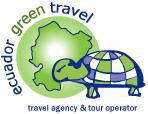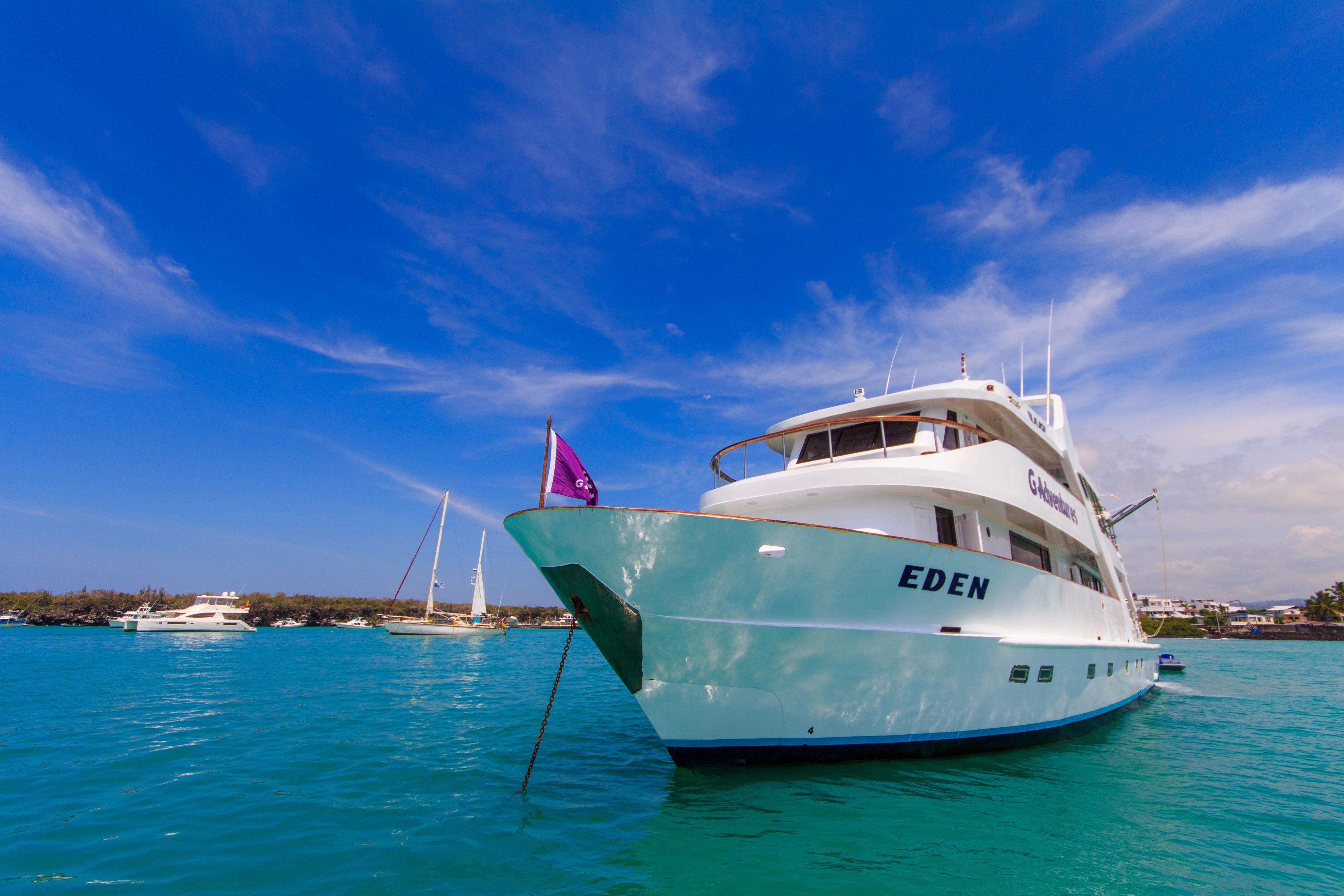DAY 1:TUESDAY
AM: ARRIVAL AT BALTRA AIRPORT
Arrival at Baltra Airport and transfer in. You must pay your Galapagos National Park entrance fee (unless it was pre-paid) and your luggage will be inspected. One of our guides will meet you, help you collect your luggage, and escort you on a short bus ride to the harbour. Here you will climb aboard the yacht. After greeting the crew and the captain, your cabins will be assigned to you and then you will enjoy your first lunch aboard.
PM: RABIDA
Rabida Island is unique because of the red colour of the rocks and sand. This, along many islands in the Galapagos, has an extraterres-trial-looking scenery because of its volcanic materials combined with the oxidation caused by the salty humid atmosphere.
The beach wall contains a green lagoon, which is an oasis on this otherwise barren islet. This saltwater pool attracts all kinds of water birds, such as pintails and often American flamingos. Many species of songbirds hide among the foliage! One of the highlights is the breeding colony of brown pelicans, the only ones in existence capa- ble of diving. On the way back, you will be picked up by inflatable boats to get ready for snorkelling.

DAY 2 : WEDNESDAY
AM: BUCCANEER COVE
Buccaneer Cove is a testament to the fact that Santiago Island was once a refuge for British buccaneers. These pirates would anchor in the protected bay to make repairs and stock up on tortoise meat among other things. The steep cliffs, where hundreds of seabirds perch in front of the dark red sand beach, are a magnificent site.
PM: EGAS PORT / ESPUMILLA BAY
You will visit Espumilla Beach, on the western coast of Santiago island. This beach has been revived as an important breeding site for turtles, as it is no longer suffering from introduced digging wild pigs. The turtles return year after year to bury their eggs into the cinnamon coloured sand dunes.
You will have time to enjoy this far-fetched beach, kayak on its coast, and explore a mangrove forest with two pretty lagoons inside.
After, we will disembark to the Puerto Egas, where you will enjoy a very unique guided walk along its coastline, masterly sculptured with black basalts and polished multi-coloured ash-layers.
All this scenery forms a photogenic location with collapsed lava tunnels, natural arches, caves and blowholes known as as ‘Darwin’s
toilet’.
The site is called Puerto Egas because at the beginning of the previous century, there was an attempt by a man named Hector Egas to extract the salt of the lagoons. The enterprise failed but it left traces of the infrastructure amidst the island’s wilderness.

DAY 3: THURSDAY
AM: ESPINOZA POINT (FERNANDINA)
Today, you will visit Espinoza Point,which is Fernandina’s only terres- trial visitors site, and one of the few locations where you will find some bizarre animal species, products of natural selection. The figurehead is the emblematic flightless cormorant that lives exclusively in the remote west of Galapagos, and could be conside- red as the ‘holy grail of evolution’. This bird lost its ability to fly, but instead became an agile marine hunter. You will also love the almost
unworldly views with the dominating cone of Volcán La Cumbre as a spectacular backdrop. The narrow headland that you walk along is the end of a lava tongue that reached the coast and solidified upon contact with the water.
PM: URBINA BAY (ISABELA)
Urbina Bay is located along the west coast of Isabela, and is close to the base of the Alcedo volcano, home to one of the rarest, most endangered species of the Galapagos: the endemic pink iguana of Isabela. The coastline here has undergone major changes recently due to volcanic activity, expanding the shore three quarters of a mile out to the sea. Observe corals, shells, molluscs and many curious organisms.

DAY 4: FRIDAY
AM: ELIZABETH BAY (ISABELA)
As landing is not allowed on this site, we will board the dinghies to reach the points of interests of Elizabeth Bay. We will head first to the Marielas, a group of rocky islets that where Galapagos penguins have formed a colony. The biggest colonies of penguins are found in this area due to the cooler waters of the west coast of Isabela. This area is also the home of the biggest specimens of Marine Iguanas, due to the abundant supply of algae, their primary food.
The dinghy will than take us through a narrow cove, flanked by some unusually tall mangroves of the three species (red, black, and white mangroves). These calm waters make possible to see golden rays, spotted eagle rays, white-tip sharks and green turtles swimming around. The cove at Elizabeth Bay is one of the best places for kayaking in Galapagos.
PM: MORENO POINT (ISABELA)
During the night we navigated to the northwest coast of Isabela, where two huge volcanoes are found, the Sierra Negra and the Cerro Azul. In between these two is located our visit point, Punta Moreno. There, we will follow a trail that runs along a solidified black lava flow until we reach a complex of tidal lagoons, where sharks and marine turtles are often seen. Several species of birds can also be visible, including flamingos, which are found around the lakes and mangroves.

DAY 5: SATURDAY
AM: TINTORERAS ISLET/ VOLCANO CHICO (ISABELA)
Just outside the port of Puerto Villamil, a group of islets protrude above the ocean. They are the remains of a lava stream which reached the ocean and solidified. At low tide, marine life is trapped in internal pools, including spectacular whitetip sharks (called "Tintore-ras" in Spanish, giving the site its name). At this unique site, you can watch them comfortably from the shore in the crystal clear waters, close to turtles and graceful eagle rays.
On this islet also breed the largest marine iguanas in Galapagos, some members reaching a length of 1.5 m/5 ft! The rocky coastline with its intertidal life attracts light-footed crabs, lava herons and Galapagos penguins. The tour continues to the dome of the Chico Volcano and let you stare right into the throat of this lateral vent, that breaths escaping vapours. Fissures, smoking fumaroles, cascades and lava tubes of solidified lava illustrate that all this has been created recently.
PM: WALL OF TEARS / WETLANDS (ISABELA)
Back on the coast, the road leads to the Flamingo Lagoon, an impor-tant spot for spotting the elegant flamingos. Afterwards, we will visit the local tortoise breeding centre, where you can see hundreds of giant Galapagos tortoises of all sizes.
The hatchlings are not gigantic at all, even smaller than the size of your hand! This project was created to rescue the endangered populations of the two southernmost volcanoes of Isabela. We will finish the tour at the historic "Wall of Tears", a massive wall made of sharp lava chunks built by political prisoners during the 1950s.

DAY 6: SUNDAY
AM: CHARLES DARWIN RESEARCH STATION (SANTA CRUZ)
The dinghies will bring you to the touristic pier of Puerto Ayora, in Santa Cruz island, from where you will be brought to the Charles Darwin Research Station. This institution was named after the British naturalist who developed his Theory of Evolution after visiting these islands in 1835, and works on the conservation and restoration of the Galapagos ecosystems, as well as for the sustainable development of its communi- ties.
There is an interpretation centre about the National Park and its Marine Reserve. The most memorable part of your visit will probably be the successful breeding centre and the enclosures with Galapagos gianttortoises.
PM: HIGHLANDS / TWIN CRATER (SANTA CRUZ)
Santa Cruz offers excellent opportunities for viewing wild Galapagos giant tortoises, roaming through pastures in the agricultural zone and in the transition zone of adjacent El Chato Tortoise Reserve. In this rainy and exuberant highlands are located the Twin Craters, impressive lava formations that appeared during a volcanic erup-tion thousands of years ago, and now are covered by forest. It is a great spot for bird watching: the endemic carpenter finch, which is considered a holy-grail of evolution, can sometimes be seen in these areas using tools.

DAY 7: MONDAY
AM: LOBOS ISLET (ISABELA)
Lobos Islet harbours a colony of Galapagos sea lions. As in other colo-nies in the archipelago, you can approach nurturing females within a few metres. During breeding season this colony is also visited by terri-torial males, defending and mating their harem.
There are two other emblematic species breeding here: male blue-footed boobies and great frigate birds who try to impress the females (and tourists) with clumsy dances, heaving their feet or blowing up their balloon-sized scarlet pouches.

Transfer to San Cristobal airport





















